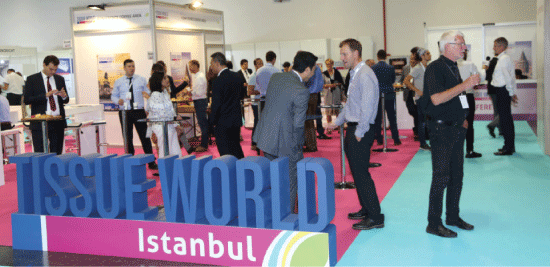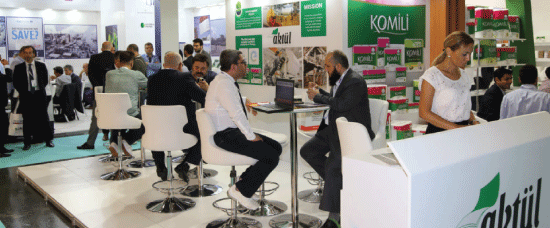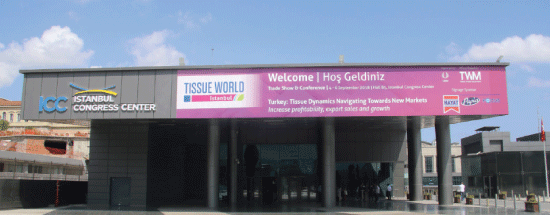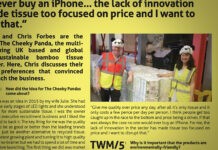An impressive 66 exhibiting companies and a total of 1,767 participants have attended the second Tissue World Istanbul exhibition and conference. Held in Istanbul between 4-6 September, exhibitors from 14 countries included tissue mills and a range of suppliers including chemicals, wrapping/packaging equipment, converting machinery, packaging equipment and non-woven machinery. The Istanbul exhibition also differentiated itself from other Tissue World events by bringing leading finished product manufacturers together on the show floor. Companies such as Aktül Kağıt, Eczacıbaşı Tüketim Ürünleri, Hayat Kimya, and Lila Group served as the main attraction for tissue trading companies and distributors.
Holding 300,000 – 350,000 tonnes of the regional tissue import and export business, these companies account for over 40% of the regional tissue business. This was a first to feature nonwoven machinery suppliers.
Overall, exhibitors came from Bangladesh, China, Germany, India, Italy, Korea, Netherlands, Pakistan, Serbia, Slovakia, Switzerland, Turkey, UAE and the USA. Some 143 delegates also attended the conference, which had the theme: “Turkey: tissue dynamics navigating towards new markets – increase profitability, export sales and growth.”
The first day’s Senior Management Symposium discussed the geopolitical and economic overview of the tissue market and its dynamics. This was also the basis for the subsequent Executive Panel Discussion which gathered distinguished representatives from major players in the tissue industry, including Lütfi Aydin, global tissue director of Hayat Kimya; Erdem Ülkümen, plants director of Eczacıbaşı Tüketim Ürünleri; Ibrahim Gökce, production director from Aktül Kağıt; and Alp Öğücü, general manager of Lila Group. It was the second full Tissue World Istanbul exhibition and conference, while a conference-only event took place in 2014.

Day 1 – Senior Management Symposium
Turkey: economic outlook and balance of risks
Seda Guler Mert, deputy chief economist, Garanti Bank, Turkey
KEY MESSAGES
• The global expansion remains at a steady pace, but less synchronised. Risks related to political uncertainty, vulnerabilities in emerging economies and trade protectionism.
• Recent data pose downside risks on the degree of expected cool-down in the Turkish economy; though a comprehensive policy mix could serve as a balancing factor.
• Inflation reached worrying levels with continued deterioration in pricing behaviour and exceptionally high food inflation. Given the depreciation pressure over Turkish Lira (TL), risks on inflation are clearly on the upside.
• Anti-inflation strategy should be urgently followed (including all policies and accepting lower but healthier economic growth). Monetary transmission mechanism should be enhanced by prudent fiscal policies.
• Higher oil prices will weigh on current account balance this year, though the adjustment will be much clearer starting from 2019.
Global environment: global growth continues, but risks are intensifying
1 The pace of global expansion is being maintained, but is less synchronised. Growth is robust in the US due to the fiscal stimulus and stable in China, but it has declined in Europe
2 Increased protectionism. At the moment, its impact on growth is limited, but it could be greater if the measures under discussion were to be implemented.
3 Higher inflation and drag on growth in oil-importing countries.
4 Different pace of monetary normalisation in Europe and the United States. Strengthening of the dollar and tightening of global financial conditions.
5 More volatility in emerging markets. Increased financial tensions due to increased financing costs and protectionist threats.
6 Global risks are intensifying. The possibility of a trade war comes together with greater risks in emerging economies and in Europe. Robust global economy despite growing uncertainty.
Global growth continues, supported by private consumption and investment, but with growing differences by region. Confidence indicators show some moderation, but remain at high levels. Limited effect of approved tariff increases, but significant if those being discussed are implemented. The tariff increases approved by the US would have a limited direct impact. With a protectionist escalation, the negative effect on growth would also be significant in the US.
The effect, smaller in Europe, would differ by country and would, above all, affect Germany and the countries in Eastern Europe.
The growth of global GDP could be reduced by around 0.2% just due to the trade channel.
The strength of the US dollar and higher interest rates are causing an adjustment in emerging markets.
Stable growth in the US, but a slowdown in other areas; Challenging times ahead to be tackled with policy determination; Emerging markets woes, macroeconomic imbalances and uncertainty about policies lead to sharp reaction of Turkish financial assets.
Global risks: the main one is a trade war, but those associated with emerging economies and Europe are increasing.
Tissue market dynamics with focus on the MENA region including Turkey
Bodo Kottwitz, principal, Bkay Tissue, Germany
Total population in the MENA Region, 2016: 513m people. The three largestcountries, Egypt, Iran and Turkey, account for half of the total population. As a comparison: Western Europe has a population of 422m people … with nearly four times the tissue consumption as the MENA region.
RECENT MARKET TRENDS
Total tissue consumption MENA region by main country 2017: 1.88m tonnes (partly preliminary data);
The five largest countries Turkey, KSA, Iran, Egypt and Israel account for some 70% of the total regional consumption. Egypt and Iran, the countries with 1/3 of the regional population, account for less than 1/5 of tissue consumption;
Estimated structure of tissue demand in the MENA region, 2017 – not representative for the region as a whole! Facial tissue/hankies dominate in the Arab countries, toilet paper in Turkey and Israel. A slight increase towards toilet paper and towelling can be expected: facial/hankies 39%, toilet paper 35%, towelling 15%, napkins 10%, other 1%.
Recent tissue market growth in the MENA region
Political turbulences lowered the average growth in 2010-2014, but in 2015 growth returned onto its former path while new problems lowered the growth again in 2016. 2017 was similar to the year before. Average historic growth 8.5% per annum.
Volume growth of tissue consumption in the MENA region by main country, 2006-2016 Turkey’s growth has been the largest by volume in the past 10 years … in the magnitude of one single-width tissue machine per year. But imagine the impact of a large tissue machine in the UAE… Tissue net exporters and net importers in the MENA region, 2016 and 2017 where available Turkey (#4 net exporter worldwide and #2 for parent rolls) and Egypt the main exporters – UAE perhaps soon #3 with huge capacity increase? Saudi Arabia, Iraq and Israel the main net importers.
Turkish tissue export growth, 2005-2017
Turkey exports tissue, mainly parent rolls, to many destinations with the UK, Greece and Israel being the largest buyers exceeding 70% is some years; major export growth jumps in 2016 and 2018 being on similar level to 2017.
FUTURE DEMAND PROSPECTS
Tissue demand in the MENA Region until 2026: market expansion will continue and regional consumption will grow by 1.3m tonnes and exceed 3.0m tonnes by 2026. However, economical/political uncertainties also exist and this growth should not be taken for granted.
DEMAND-SUPPLY OUTLOOK
Expected tissue net trade balance in MENA region, 2012-2020
New, partly export-oriented investments will likely increase tissue net exports further to about 140,000 tonnes by 2021 – this assumption is already considered in the supply/demand balance.
Conclusions:
Economic and political uncertainties, weak currency, inflation, IFC/EBRD financings threat for Turkey, war, taxes/ duties, sanctions, Brexit. New markets .. pulp price – way out? Tight international (Asian) competition, increased energy prices in single countries weakening regional cost benefits, industry consolidation?
Winning in West Africa: critical success factors and insights for foreign companies
Clarence Nartey, country director, Invest in Africa (Ghana), Ghana
West Africa is home to three of the fastest growing economies in 2018: Ghana, Cote D’Ivoire, Senegal.
Turkey and Ghana: A thriving relationship. $480m* (trade volume between the two countries in 2017). Ghana is Turkey’s third largest trade partner.
Turkey and Côte d’Ivoire: A promising future $428m* (trade volume between the two countries in 2017).
Turkey and Senegal: A promising future $250m* (trade volume between the two countries in 2017).
Doing business in West Africa:
• High economic growth translates into quick return on business investment.
• Thinking of the region as a homogeneous whole.
• Lack of quality local suppliers: unable to deliver on time/to international standards.
• Most low-income consumers are not aspirational.
• Local brands unable to compete on a sustainable basis with MNC’s/ foreign brands.
There is a wide spectrum of consumers across the region and they shop in a variety of channels –
Lesser: table-tops, emerging: modern trade, pharmacy, cosmetic shops, E-Commerce, social commerce.
Dominant: groceries/general stores, open markets, convenient stores.
All channels are in a different life stage.
• Dominant channels remain the key outlet for shoppers.
• Emerging channels are where we see growth.
• Channels like table-tops are declining in relevance among shoppers.
• Groceries and open markets are the most favoured shopping destinations
A few critical success factors
Invest for the long-term but plan with short to medium term horizons.
• Focus on de-averaging (across markets).
• Have a strong risk management/ contingency planning orientation.
• For FMCG brands, execution is everything – especially in the marketplace.
• Access to cheap credit is a challenge. Consider alternative financing solutions (e.g Exim Bank type support/barter deals).
• Commit to building brands (and business models) which address social needs.
• Be ready to invest and partner with locals to get your supply chain right.

Benefits of new products and innovations
Pirkko Petäjä, principal, Pöyry Management Consulting Oy, Finland
Mikko Helin, principal, Pöyry Management Consulting Oy, Finland
1 In order to grow, add-value and improve profitability, companies need to constantly innovate, develop and renew their products and marketing.
2. Enlarging the product portfolio – with products already existing in the market, but not part of the company’s current offering.
3. Creating new products or improving existing products – new products, features, packages etc.
4. Inventing new market “segments” and new needs – recognising new consumer segments with needs for customised products.
5. Process innovations, e.g. new raw materials or technologies that lead to new or improved products, market innovations, improved efficiency or reduced costs.
How new products and innovations add value?
Besides increasing sales volumes and adding value, new products and innovations are fundamental in building product brand and image:
• Increased sales volumes
• New products in the company portfolio and/or in the market
• Improved products with new features
• New needs and market segments.
• Higher pricing
• New or improved products allowing higher price and pushing consumers to the premium end of the market
• The product portfolio becomes less vulnerable to price driven competition and pulp price fluctuations.
• Brand value
• Product innovation and differentiation is most beneficial when related to a brand the company can keep or increase the market share
• Strong brands bring producers closer to consumers
• Innovative image catches also the attention of investors and talented personnel.
Small innovations matter. Individual smallish innovations have limited value as such, but they maintain and develop the value of a basic product and lengthen its life cycle.
• Product innovation is typically led by the branded players. Product differentiation is most beneficial when related to a brand.
• Tissue and traditional hygiene products have strong market and client synergies, but some wet wipes can additionally share the same brand with tissue, with mutual benefits
HYGIENE BUSINESS – TYPICAL COMBINATION WITH TISSUE
Out of the various hygiene product businesses, selected wet wipes have the best market synergies with tissue.
• Tissue and hygiene products typically go hand in hand; especially there are market, distribution channel and client synergies.
• The global leading producers, such as P&G, K-C and Essity, are strongly present in both segments. Also in MENA many regional players, like Hayat, Eczacıbaşı, FHH and INDEVCO, have a wide range of hygiene products in their portfolio.
• There are also specific producers for both segments; many tissue producers have some selected hygiene products like wet wipes, while pure hygiene players seldom offer tissue products.
• Smaller tissue like products, such as some wet wipes, can be seen complementary to tissue products, strongly leveraging the same brand and customer base.
Market trends and demand drivers:
Consumer wipes market is experiencing healthy growth, driven particularly by personal care wipes, moist toilet tissue in the forefront.
• Basic economic growth, increasing disposable incomes and demographic developments are the fundamental drivers also for the wipe consumption.
• Essentially consumers are looking for convenience with these products. Hygienic and disinfecting reasons are also important.
• With constantly increasing relevance of environmental issues, biodegradability is becoming more and more important.
Discussing Unmet Potential in Retail Tissue in the Middle East and North Africa: Growth, Trends, Risks and Opportunities
Mike Kruiniger, analyst, Euromonitor International, UK
Caglar Altunel, analyst, Euromonitor International, Turkey
Retail tissue per region: Middle East and Africa continues to grow. Retail tissue split: paper towels fastest in value.
The Region’s Unmet Market Potential
Per capita consumption of retail tissue: UAE remains dominant. Global 3.2kg Middle East and Africa 0.9kg. Egypt leads in unmet potential in retail tissue. Unmet potential in MENA 2 Billion Kilogram. 5% of global unmet potential.
What will be driving growth in the next five years? Retail volume sales growth: Egypt – product price 2.3%, population – 2.1%, Turkey – product price – 0.5%.
TURKEY: Retail tissue continues to register double-digit growth in local currency terms.
Unit price main driver of value growth. Decline in USD
2017: – 3.6% y-o-y growth, USD current value
Stagnation in the income level of consumers hinders volume growth.
Positive volume growth continues despite the economic unease, thanks to:
Rapid urbanisation: Istanbul’s population is 15m as of end of 2017;
Modern grocery retailers: value share of modern grocery retailers reaches 95%.
Increased urbanisation brings about an increase in the per capita retail consumption. Due to swift expansion of modern groceries, retail tissue has been reaching larger masses.
Key Takeaways: Strong unmet potential, markets of the future, economy products, multi-usage, strong local players.


























